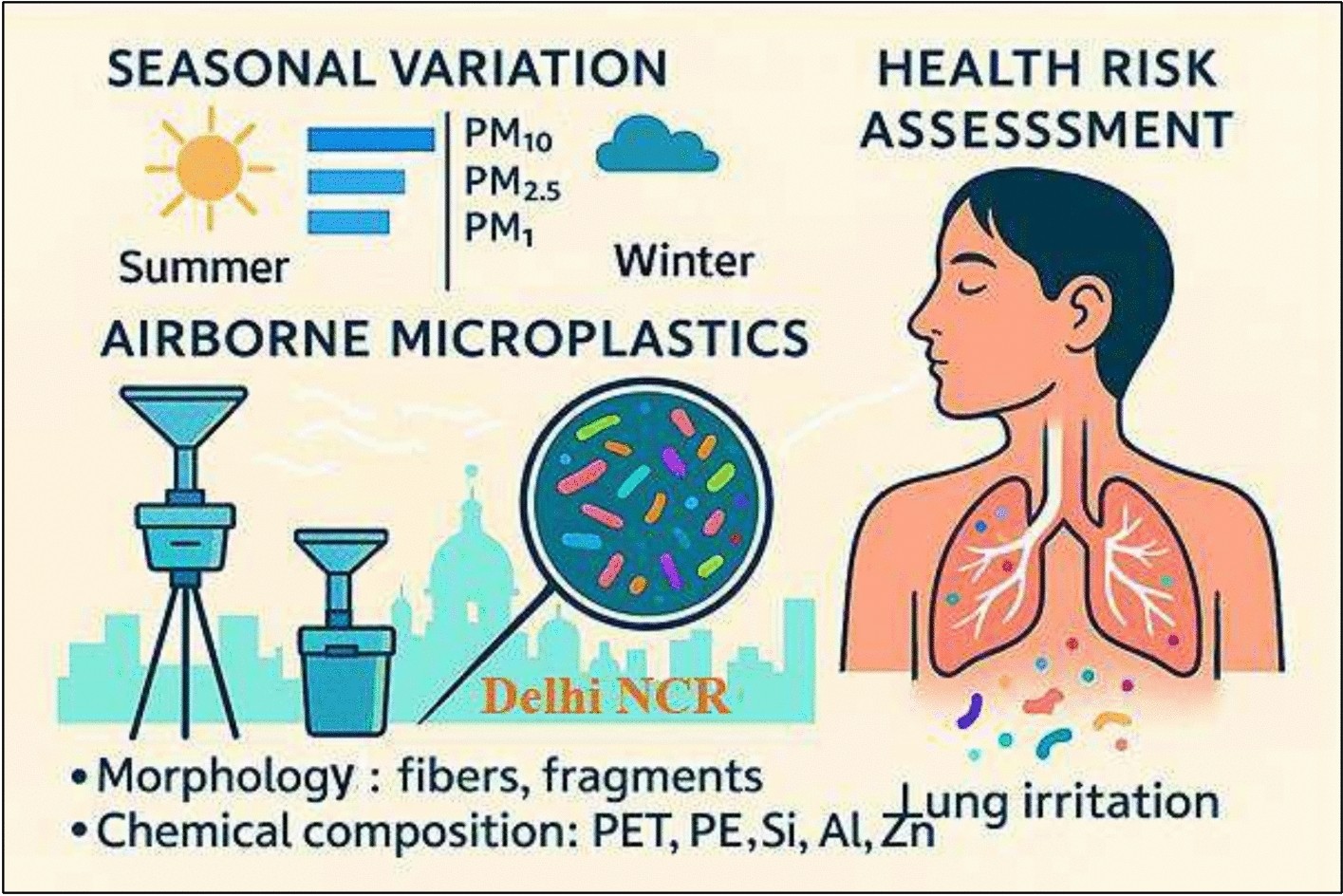Introduction:
Urban air pollution in India has long been associated with dust, smoke, exhaust, and industrial emissions. But new scientific evidence has added a disturbing element to this list- tiny, airborne plastic particles that we unknowingly inhale every day. A multidisciplinary study by IISER Kolkata has revealed that inhalable microplastics (iMPs), invisible to the eye, are now a persistent and significant component of the air in major Indian cities. Their presence introduces a new concern of health and environmental risks.
What the Study Found:
The study of IISER Kolkata directly measured microplastic particles at human breathing height in the crowded markets of Delhi, Kolkata, Mumbai, and Chennai.
Key concentration levels recorded:
-
- Kolkata: 14.23 µg/m³ (highest)
- Delhi: 14.18 µg/m³
- Chennai: 4 µg/m³
- Mumbai: 2.65 µg/m³
- Kolkata: 14.23 µg/m³ (highest)
According to the researchers, this means an average resident of Kolkata may inhale around 2.9 grams of microplastics over a lifetime, equivalent to breathing in a small plastic bottle gradually.
What Are Inhalable Microplastics?
India’s air quality discussions usually revolve around PM10 and PM2.5, which are particles from dust, combustion, and industrial activity. The new study highlights that microplastics contribute significantly to this category:
-
- Up to 5% of PM10
- Up to 2.5% of PM2.5
- Up to 5% of PM10
Microplastics are extremely small fragments of plastic, typically less than 5 mm. However, the study focuses on an even smaller category: inhalable microplastics, which measure under 10 micrometres (µm).
These particles are so fine that they can escape the body’s natural defences, travel deep into the lungs, and in some cases reach the bloodstream. Once inside, they may affect vital organs and trigger long-term health complications.
Unlike typical dust particles, microplastics do not degrade, dissolve, or settle easily. Their lightweight and aerodynamic shapes keep them suspended for long periods, enabling them to travel long distances across cities and, potentially, across national borders.
Studying microplastics in lungs and blood is extremely complex. Analytical methods have limitations:
-
- Tools like μFTIR and μRaman can only detect particles larger than 5–20 µm.
- Smaller microplastics and nanoplastics often go undetected.
- Current polymer libraries contain mostly pristine plastics, not aged or weathered particles that dominate human exposure.
- Additives are hard to identify with imaging tools—requiring chemical methods like pyrolysis–GC/MS.
- Tools like μFTIR and μRaman can only detect particles larger than 5–20 µm.
What do microplastics carry?
1. They carry pathogens
Using high-throughput sequencing, researchers identified:
-
-
- Aspergillus fumigatus
- Candida, a known respiratory pathogen
- Bacillus species carrying antibiotic-resistance and virulence genes
- Aspergillus fumigatus
-
These microbes hitchhike on plastic surfaces and remain airborne for long durations, increasing the risk of respiratory infections.
2. They carry toxic additives
The study detected:
-
-
- Diethyl phthalate (DEP), a plasticiser and fragrance stabiliser
- Emissions from cosmetics, packaging, PVC items, and paints
- Diethyl phthalate (DEP), a plasticiser and fragrance stabiliser
-
Long-term exposure to DEP is associated with:
-
-
- hormonal imbalance
- fertility issues
- developmental disorders
- respiratory irritation
- hormonal imbalance
-
Delhi, Kolkata, and Mumbai showed the highest DEP levels.
3. They carry heavy metals like lead
Kolkata and Delhi recorded lead levels exceeding national safety limits. Lead released from tyre wear, industrial waste, degraded PVC, and plastics can enter the bloodstream on inhalation.
Chronic lead exposure is linked with:
-
-
- cognitive decline in children
- neurological damage
- kidney and liver impairment
- developmental delays
- cognitive decline in children
-
How Microplastics Behave Inside the Human Body:
Microplastics smaller than 10 micrometres can move through the entire respiratory system. Those in the 1–5 micrometre range are especially dangerous because:
-
-
- they settle in the nasopharyngeal and bronchial regions,
- fragments of 1 micrometre and smaller can reach the alveoli, the deepest part of the lungs where gas exchange occurs.
- they settle in the nasopharyngeal and bronchial regions,
-
Studies so far show that humans may accumulate 26 to 130 microplastic particles per day through inhalation.
Seven recent investigations into human lung tissue have detected multiple polymers, especially polypropylene (PP) and polyethylene terephthalate (PET). In some lung tumour samples, the number of microplastic fibres was found to be twice as high as in healthy tissue.
In children, bronchoalveolar samples have shown up to 332 microplastic particles, often even more than in adults
Once inside:
-
-
- They can cause inflammation
- Trigger oxidative stress
- Disturb immune responses
- Potentially move into the bloodstream
- They can cause inflammation
-
Researchers warn that the health effects of long-term exposure remain largely unknown, but early findings link microplastics to:
-
-
- Respiratory disorders: chronic inflammation, asthma-like symptoms
- Endocrine disruption: due to additives like DEP
- Gastrointestinal and metabolic disorders
- Risk of cancers: especially when microplastics burn and release complex pollutants
- Immune system impairment: accumulation in lymph nodes
- Potential systemic effects: once they enter the bloodstream
- Respiratory disorders: chronic inflammation, asthma-like symptoms
-
Way Forward:
The rise of airborne microplastics overlaps with other environmental threats, making it a complex “One Health” problem that links human health, urban systems, and environmental quality.
Lifestyle Choices
-
-
- Reduce use of single-use plastics
- Choose natural fibres such as cotton or khadi instead of synthetic clothing
- Avoid heavily weathered or low-quality synthetic textiles
- Support better waste segregation at the household and community level
- Reduce use of single-use plastics
-
Urban Planning Solutions
-
-
- Expand green spaces, which act as natural filters
- Promote vehicle-free zones in markets and dense neighborhoods
- Improve waste management systems to cut down plastic-burning and littering
- Introduce stricter controls on industrial emissions and tire pollution
- Expand green spaces, which act as natural filters
-
Policy-Level Needs
-
-
- National guidelines on microplastic monitoring in air
- Regulation of additives, especially endocrine-disrupting chemicals
- Stronger Extended Producer Responsibility (EPR) enforcement
- Investment in clean urban mobility
- Phasing out problematic plastics
- National guidelines on microplastic monitoring in air
-
Need for Better Research
· Standardized monitoring methods across cities
· Advanced analytical techniques such as Raman microscopy and Py-GC/MS
· Studies on how microplastics interact with lung tissue
· Tracking microplastic-associated chemicals in human blood and urine
· Understanding long-term impacts, especially in vulnerable populations
· Better mapping of urban sources, including traffic and waste sites
Conclusion:
The discovery of inhalable microplastics as an emerging class of air pollutants forces India to rethink its understanding of urban pollution. These near-invisible fragments carry microbes, heavy metals, and toxic chemicals, posing multi-layered health risks. While metropolitan cities like Delhi and Kolkata show the highest contamination, the problem is widespread and growing.
UPSC/PSC Main Question: Inhalable microplastics (iMPs) are emerging as vectors of pathogens, toxic additives and heavy metals. How this complicates conventional air-quality management frameworks in Indian cities? Analyse. |








